Strawberry Hill Awarded Decorative Arts Society Collections Access Grant
Written by Dr Rosalind White, Collections Assistant
We’re thrilled to share some fantastic news; Strawberry Hill House has been awarded a Collections Access Grant from the Decorative Arts Society.
Building upon ongoing efforts to establish a comprehensive collections database, this grant will allow us to extend cataloguing and research initiatives to encompass Strawberry Hill’s post-Walpole legacy.
In the nineteenth and early twentieth century, the house was occupied, furnished, and decorated with sumptuous collections by two owners: Lady Frances Waldegrave and the Stern family.
Born in 1821, Lady Frances Waldegrave (née Braham) inherited the house through her first marriage to John Waldegrave, the grandson of Horace Walpole’s great niece, Elizabeth. Following John’s death, just a year after their wedding, she married John’s brother, George, the 7th Earl Waldegrave. Within seven months of marriage, George’s ‘riotous behaviour’ landed him in prison. In mounting debt, he sold off Walpole’s treasured collection in what became known as the Great Sale of 1842.
For fourteen years, Strawberry Hill languished, its rooms virtually empty and neglected. In 1854, a visitor noted its impending ruin, remarking ‘its end is near at hand’.
Armed with a substantial inheritance and having married her third husband, George Granville Harcourt, Lady Waldegrave embarked on an ambitious project: to breathe new life into Walpole’s beloved home. She adorned the hallway ceiling with stained-glass quatrefoil skylights and a constellation of gold stars on a backdrop of deep blue. She lovingly picked out wallpaper, cultivating a careful formula for its selection: floral patterns for women’s chambers and bird motifs for men’s. Her dedication to the decorative arts extended right down to the doorknobs, which — to this day — house exquisite examples of nineteenth-century craftsmanship.
‘Here I am’, she wrote in 1857, ‘settled in this most enchanting of all charming places. I am certain that you have not the faintest idea of its now wonderful beauty. Altho’ it poured all yesterday [guests] thought it the most intoxicating place they had ever seen’.
In the late 1850s and early 1860s, she made a host of architectural alterations that both improved the house’s practicalities and exaggerated its Gothic silhouette: adding an entirely new wing, along with a battlemented wall, entrance gateway, and clock-turret, topped off with four moulded Tudor chimneystacks each with their own unique pattern. Edward Lear observed her hands-on involvement describing her as ‘as proud as possible, happy as a child… in working dress, plain black dress tucked up… giving directions to… the builders about a hundred things’.
Her fourth and final marriage, in 1863, to the Liberal MP Chichester Fortescue, saw Strawberry Hill transform into a hub frequented by enough high-society guests to cause periodic traffic jams all the way back to Twickenham Station. As The Graphic put it, ‘Strawberry Hill was the Mecca towards which the eyes of the ambitious turned with longing looks, for it was there that Lady Waldegrave held court, and very carefully did she choose her courtiers… This one craved for a place, Lady Waldegrave procured it for him; that one was eager to obtain a title, Lady Waldegrave obtained it for him; another yearned for social recognition, in an instant every door in Mayfair flew open to receive him’.
During this epoch of her life, Lady Waldegrave masterfully used the house and its interiors to build upon her marriage’s social and political capital. As Claire Leighton has detailed in her chapter dedicated to Lady Waldegrave’s exacting design choices, the rooms of Strawberry Hill were carefully curated to promote private discussion with the buxom, button-tufted furniture arranged in discrete clusters. What’s more, she had a ‘keen awareness of the politics of display’, strategically grafting herself onto Walpole’s legacy, by incorporating her personal crest, initials, and coronet into countless decorative objects throughout the house — from the Gallery’s French parquet floor, inlaid with her shield and insignia, to the heraldic badges in the Round Room’s stained glass.
At the turn of the century, Strawberry Hill was purchased by Herman, Baron de Stern, a member of the European merchant banking family, a Portuguese baron, and the 13th richest man in Britain. His son Herbert later married Aimée Geraldine Bradshaw, and together they brought Strawberry Hill to life once more. Following Herbert de Stern’s elevation to the peerage as Baron Michelham of Hellingly, the garden parties at Strawberry Hill grew increasingly lavish, attracting prime ministers, foreign princes, and other notable guests. Fashionable magazines known for their high society focus avidly covered these events, with publications like The Tatler and The Sketch producing illustrated inserts to capture the glamorous parties of 1908, 1912, and 1914.
Today, Lord and Lady Michelham’s presence at Strawberry Hill is less detectable than Lady Waldegrave’s, but certainly evident. In their time at Strawberry Hill, the Stern family were clients of Henry and Joseph Duveen, famed interior decorators of Jewish Dutch origin, who courted international fame for selling French antique furnishings, objects d’art and old master paintings. Though the gilded tables with their cabriole legs and grandiose silver candelabras are no more, a beautiful neo-classical relief sculpture of Virgilia by Thomas Woolner (1871) is still visible in the Pantry.
Most notable today is the Sterns’ transformation of the Blue Breakfast Parlour into a plush ‘Turkish Boudoir’. Styled as an opulent smoking room, the rich teal walls are bordered by intricate mahogany fretwork on the dado, highlighted with gilt accents. Epitomising the era’s fascination with ‘exotic’ Eastern aesthetics, a striking tented ceiling envelops the room. The centrally draped velvet tent, originally turquoise and now a blend of green, blue, and yellow, features beautiful appliquéd and embroidered arabesque motifs and scrolling foliage.
In their time, both Lady Waldegrave and the Stern family left indelible marks on Strawberry Hill, though their tenure is often overshadowed by the era of Horace Walpole. With the support of the Anniversary Fund of The Decorative Arts Society, we look forward to ensuring that their legacies are not forgotten.
As we embark on this exciting cataloguing and research initiative, we would welcome correspondence from anyone with knowledge or artefacts associated with the Waldegrave or Stern families.
You can contact our Curator, Silvia Davoli, at silvia.davoli@strawberryhillhouse.org.uk
Sources
Carlingford, Chichester Samuel Parkinson-Fortescue Baron. A Selection from the Diaries from 1851 to 1862 of Chichester Fortescue, Lord Carlingford, K. P. J. Murray, 1958.
Crook, J. Mordaunt. ‘Strawberry Hill Revisited– II’. Country Life (Archive : 1901 – 2005), vol. 154, no. 3964, 14 June 1973, pp. 1726–30.
Davoli, Silvia. ‘“I Shall Now Go on Selling as Much as I Can to These People”: Duveen Brothers and the Making of the Stern–Michelham Collection’. Journal of the History of Collections, vol. 34, no. 3, Oct. 2022, pp. 413–26.
Davoli, Silvia. ‘The Unexpected Jewish Past of Strawberry Hill House’, Strawberry Hill House & Garden website.
Leighton, Claire. ‘Designing a Political Space’. Narrating Objects, Collecting Stories: Essays in Honour of Professor Susan M. Pearce, edited by Sandra H. Dudley, Routledge, 2012, pp. 153–67.
Marmaduke. ‘Court and Club’. The Graphic, vol. 57, no. 1,471, Feb. 1898, p. 162.
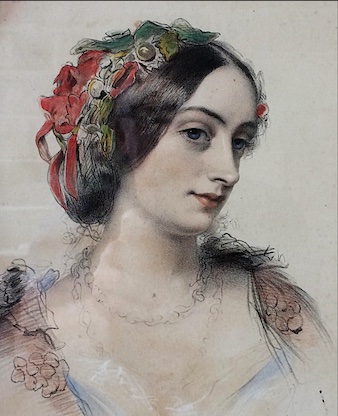
James Rannie Swinton, Portrait of Lady Waldegrave, 1850, watercolour. Private collection.
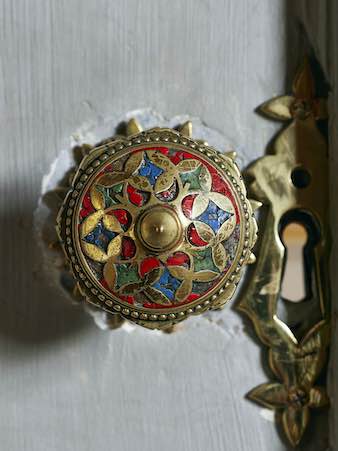
The Waldegrave Door Handle, specially commissioned for Strawberry Hill by Lady Waldegrave. As part of the fabric of the building, this object has been leased to the Strawberry Hill Trust by the Catholic Education Service. Photo: Killian O’Sullivan.
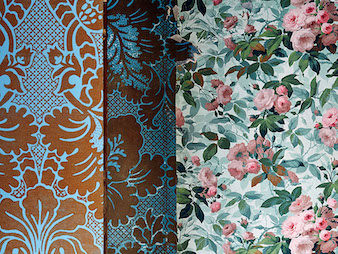
Two Wallpapers, 1756 and 1856. Horace Walpole’s wallpaper on the left is made with flock, imitating luxurious damask hangings. Lady Waldegrave’s wallpaper with cabbage roses, made in France and supplied by Cowtan & Sons. As part of the fabric of the building, these wallpapers have been leased to the Strawberry Hill Trust by the Catholic Education Service. Photo: Killian O’Sullivan.
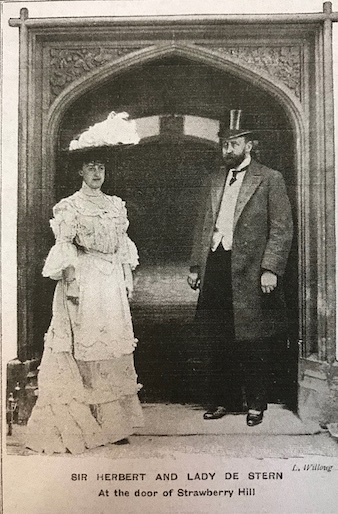
Sir Herbert and Lady de Stern at the door of Strawberry Hill’, illustrated in Sketch, 1908.
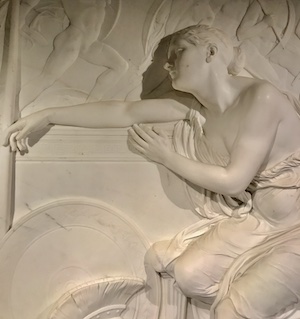
Detail of a neo-classical relief sculpture of Virgilia (1871) by Thomas Woolner, one of the founding members of the Pre-Raphaelite Brotherhood. As part of the fabric of the building, this object is leased to the Strawberry Hill Trust by the Catholic Education Service. Photo: Killian O’Sullivan.
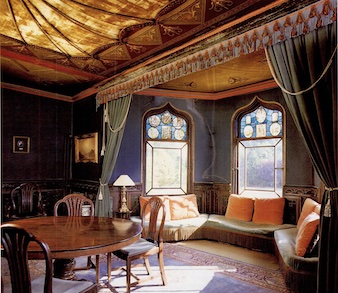
Blue Breakfast Room at Strawberry Hill. This room was converted into a tented ‘Turkish’ boudoir by the Stern family. Photographed in Country Life, 1995.